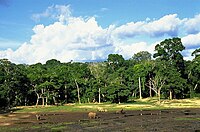
Photo from wikipedia
Background and Aim: Bacillus cereus and Staphylococcus aureus cause foodborne intoxication in humans and animals. Pathogens can produce biofilms controlled by the quorum sensing system. The study aimed to investigate… Click to show full abstract
Background and Aim: Bacillus cereus and Staphylococcus aureus cause foodborne intoxication in humans and animals. Pathogens can produce biofilms controlled by the quorum sensing system. The study aimed to investigate the antibacterial, antibiofilm, and anti-quorum sensing activities of Coffea canephora P. ex Fr. (Robusta coffee) extracts against B. cereus and S. aureus. Materials and Methods: Ethanol extracts of fruit peels and seeds of Robusta coffee were tested for antibacterial activity against B. cereus and S. aureus using a broth microdilution assay. Reduction of the biofilm formation and elimination of the viability of mature biofilm-grown cells of B. cereus and S. aureus were determined. Inhibition of quorum sensing activity in Chromobacterium violaceum by the extracts was investigated using the disk diffusion method and flask incubation assay. Results: Fresh fruit peel extract showed the strongest antibacterial activity against B. cereus and S. aureus with minimum inhibitory concentration (MIC) values of 2 and 4 mg/mL, respectively. However, the extracts did not inhibit Escherichia coli, avian pathogenic E. coli, and Pseudomonas aeruginosa at 8 mg/mL. Significant inhibition of biofilm formation at 1/2 × MIC of the fresh peel extract was detected in B. cereus (56.37%) and S. aureus (39.69 %), respectively. At 8 × MIC of the fresh peel extract, a significant elimination of the mature biofilm viability was detected in B. cereus (92.48%) and S. aureus (74.49%), respectively. The results showed that fresh and dried peel fruit extracts at 1/2 × MIC significantly reduced violacein production with the highest percentage inhibition ranging from 44.53 to 47.48% at 24 h (p ≤ 0.05). Conclusion: The results of the present study suggest the potential therapeutic benefits of Robusta coffee extracts in inhibiting the growth, biofilm, and quorum sensing of both B. cereus and S. aureus. The results put forward an alternative strategy to control the foodborne intoxications caused by both pathogens.
Journal Title: Veterinary World
Year Published: 2022
Link to full text (if available)
Share on Social Media: Sign Up to like & get
recommendations!